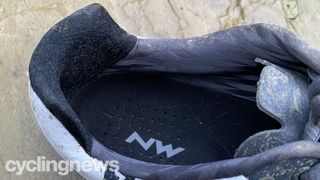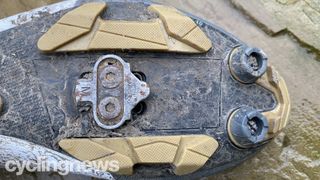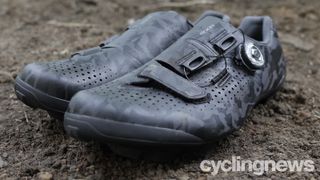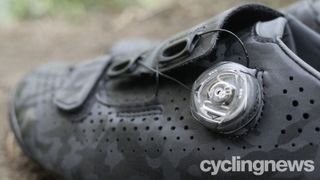Gravel is no longer the awkward cousin at the cycling party; it’s a fully fledged separate discipline now, with unique demands that differentiate it from both road and mountain biking, though of course there is some crossover. You’ve got your hands on one of the best gravel bikes out there, with some of the best cargo bib shorts and a fashionable piece of bicycle luggage, but you need something to go on your feet. In days gone by you’d have a toss-up between some mountain bike shoes, or just using road cycling shoes and hoping you could get away without a hike-a-bike.
Well, now you don’t have to choose; gravel has its own dedicated shoes. We’ve put together a list of the best ones you can buy today, along with some from the mountain bike world that we think fit the gravel segment just as well.
Unsure about what you’re looking for? Don’t worry, we’ve included a guide at the bottom of the page to guide you through any queries you may have.
Best gravel bike shoes
Specialized made the bold proclamation that its S-Works Recon shoes were the “fastest off-road shoes on the market”. Designed as a cross-country race shoe, the Recon’s staggeringly stiff sole and light weight means that it is also one of the best all-round gravel shoes available.
The hard-wearing Dyneema uppers are secured over the top of the foot with two premium aluminium Boa S3 Snap dials. The non-stretch uppers and rigid heel cup offer an aggressive fit which is more comfortable in use than it is off the bike. The S3 Snap dials don’t have a pop release but the cables can be unhooked for fast shoe removal. You need to be careful of tongue placement as it can dig into the front of the ankle but overall it didn’t cause much discomfort.
The sole is the crux of the Recon which boasts the same stiffness as the road equivalent. Power transfer is staggering, driving every bit of power into the cranks. On the flip side they have a very wooden feel and on longer rides can begin to feel a bit fatiguing as every vibration through the crank is transmitted to the foot.
If you are looking for a shoe that will give the top-level performance, the S-Works Recon is a shoe ready to race on anything no matter if its gravel road, cyclo-cross course or cross-country mountain bike trail. The overall quality of the shoe has so far been excellent with only the exposed carbon sole showing any marks from use. The sole will likely divide opinions, for power transfer it is unmatched on test but the rigidity does nothing to isolate vibrations and for endurance riders, it might be too harsh.
Find out how they earned their spot in this guide in our Specialized S-Works Recon review.
Giro uses its breathable triangulated weave Synchwire mesh upper for this gravel Sector shoe. The Synchwire is overlaid with a web of bonded rubbery ‘Exo Structure’ for additional support. Two rubber wrapped Boa L6 dials tension stainless steel laces over a lightly padded split tongue. Thick padding secures the heel and the insole has a medium arch support orthotic. The heel top is reflective, too.
The lightweight mesh construction does an impressive job of assuring a comfortable fit and providing a very uniform closure. The heel is well shaped to avoid any lift at the back of the foot. Wider- or tall-footed testers found them equally comfortable and they come in a women’s fit as well. The insole orthotic is noticeably supportive without being divisively obvious like some lumpier shoes.
The sole is decently stiff as well, assuring plenty of power transfer should you need to gun it without becoming fatiguing or punishing after many miles of gravel riding. The tread is very familiar to Giro shoe fans and does a decent job of gripping the ground if any portaging is required.
Want to find out more? Read our in-depth Giro Sector review.
Aesthetically, Bont’s shoes are some of the most polarising in the bike industry but also they take a bit of work to achieve foot nirvana. Bont’s take on cycling shoes is a bit different to the rest of the industry, using a wide ‘bathtub’ shape and last, which includes longitudinal arch support and lateral forefoot support — this keeps all your joints running smoothly.
The trick up the Australian outfit’s sleeve is the resin used throughout the shoes that hits its glass transition temp at 70-degrees Celsius, meaning you can mould them at home. It can take a few tries to get them just right but, when you do, they are some of the most comfortable shoes on the market.
The Vaypor G is built around the Chassis of the Vaypor + with the addition of replaceable lugs bolted onto the bottom. They are supremely stiff which is great when you’re on the bike, but a little awkward if you have to walk around or scramble up a steep hill.
Read how these earned a four-star rating in our Bont Vaypor G gravel shoe review.
Northwave hasn’t been shy about its styling since it rolled out deliberately mirror-imaged colourways on its 90s race shoes. The white microfibre upper with grey or orangey laces (spare in the box) plus natural gum rubber soles will undoubtedly turn some people off.
The upper features laser-cut three-point perforations on the flanks that help with foot fitting stretch and ventilation. A dovecote arrangement of tiny triangular holes over the toe box adds cooling over your pinkies without flooding at the first sign of a splash or shower. They clean up and dry quickly if you do drown them, too. Synthetic leather heel cuff, tongue and lace top detailing increase durability, add grip to the inner heel to stop lift. The cool two-tone styling continues with grey rubber reinforcing on the heel’s outside edge and a full TPU toe lining. The front sole tread also wraps up onto the toe tip to increase durability and grip.
You certainly won’t be at much of a disadvantage when it comes to racing either as the Rockster’s carbon-reinforced sole has a Northwave stiffness rating of 10 (the ranging-topping full carbon race shoes are a 14). That means power delivery feels very solid without risking numbness on long days and the enhanced support ‘race’ footbed also helps on extended rides.
Find out more information in our Northwave Rockster review.
Shimano went all-in on gravel around the release of its GRX groupset and now offers a wide range of gravel-specific componentry and apparel, including the RX8 gravel-specific shoe.
The first thing you notice when picking up the RX8s is that they are very light for a gravel shoe. The slim wrap-around tongue and uppers provide a secure fit and the Boa IP1 ratchet is intuitive to use and easy to tighten or loosen while riding. The heel cup is well moulded to eliminate heel lift and the toe box is reasonably roomy. Shimano fits the RX8s with medium arch supports and includes large inserts in the box.
On the bike, the sole (rated 10 out of 11 on Shimano’s stiffness scale) provides an excellent pedalling platform. With a stiff yet lively sole and a tread that pairs well to the Shimano XT pedals, the application of power is stable and efficient. The sole features TPU lugs and an anti-slip pad to aid walking but the narrow tread profile means they do have a tendency to roll ankles on uneven ground.
They aren’t cheap but the price is very reasonable considering the quality of the shoe. The RX8s are best suited to those looking to gravel as an extension to road riding rather than an exploration into the wilderness. The lightness really makes them akin to road shoes allowing you to dance on the pedals up climbs. When it comes to descending, the stiff yet comfortable sole filters out the worst of the vibrations. Shimano has done an excellent job refining exactly what is needed from a performance gravel shoe.
Sidi has been making road and mountain bike shoes for a while now but the Jarin is its first gravel-specific shoe. Packed with an unusual design and outrageous iridescent colour scheme, the Sidi Jarin’s are quite unlike any of the other shoes we have on this test.
Using Sidi’s own ratchet design, closure on the front of the foot is handled with a central dial while an instep closure system tightens across the top of the shoe. The dials are fiddlier than the Boa dials on the other shoes as they require you to push a button to release a lever. They also cant be backed off, instead using releasing levers that need to be squeezed on the side of the dial. I found the fit a bit odd, I have slightly narrow feet and I wasn’t able to cinch the Jarin’s down at the front as much as I would have liked. Saying that, they still felt secure on my foot and I didn’t suffer any lift or movement while riding although I did while pushing. The tongue also dug into the front of my ankle, although this is possibly due to tightening the top strap more to compensate for the looser fit at the front. Sidi does advise in the included instruction booklet that the tongue can be cut to create a gentler edge.
Where the Sidis shine is the sole which is a perfect balance of stiffness and comfort. This perfect blend is best on the test and while the RX8s come very close, the Jarin’s are just a little better. Unfortunately, it isn’t all positives for the sole: while the lugs are replaceable, they don’t feel particularly sure-footed and combined with the exposed carbon sole means that in situations such as river crossings, if the lug misses there is no additional rubber to stop you slipping. I also found clipping in and out of the pedals somewhat vague. I used the same Shimano XT pedals throughout testing and every shoe was fitted with brand new cleats, yet the Sidis were the only ones to have this issue. The Jarin’s are also not light, weighing in at 727g they are noticeably heavier than many of the other shoes on test.
While the sole and outrageous colourway really appeals to me, the complicated Techno System dials and odd fit were detracting. Fit is personal and if you are already a fan of Sidi then these are going to be an excellent choice. If unsure, I would recommend trying before you buy.
The Fizik Terra X5 is an excellent mid-range cross-country mountain bike shoe that is more than capable of taking on gravel mileage as well.
The light upper conforms well to the foot providing instant comfort and uses a single Boa L6 dial closure which clicks tighter or pops to release. I did find that I needed to increase the tightness mid rides but as the dial is easy to use it was never an issue and only required a single audible click. The uppers feature a lot of perforations along the sides of the foot for ventilation and Fizik has added a pull to help pull them on. Toe and heel boxes are supported although the instep of the shoe has very thin material.
The sole can’t compete with the ultra-stiff carbon soles of some of the other shoes but I never felt it lacked when pedalling hard out the saddle. It’s also a very forgiving sole filtering out vibrations from the trail. The aggressive tread gives a good walking platform and will hook onto rocky or loose surfaces to aid traction. The injected carbon sole has visually fared much better than the exposed carbon soles on the premium shoes.
I was very impressed with the Terra X5, comfort is easily dialled in without the need to fiddle the tongue or outers into the correct position. It would be nice to see a Boa system that could be backed off but this would add cost to what is a very well priced and good value shoe. Sole performance is decent as well, providing more than enough stiffness for the majority of gravel riders. If black isn’t your thing Fizik sells the X5 in five colour combinations as well as a suede version.
Giro says that the Privateer lace combines the comfort of its Empire shoes with the durability of the Privateer mountain bike shoes.
Giro isn’t wrong as the Privateers are supremely comfortable. The upper’s gentle mould around the foot and the long section of laces means that tightness can be adjusted down the length of the shoe. They are well cut around the ankle and although the heel cup isn’t as rigid as other shoes it still does a great job of holding the foot in place. The microfibre upper feels hard-wearing and is reinforced around the toe and heel. Perforations around the sides and tongue help with ventilation but don’t instantly let water in if you splash through a puddle.
The sole is made from nylon but really lacks stiffness: when climbing out the saddle the cleat plate can be felt under the foot. The upside is that they are very comfortable to walk in and the simple tread combined with toe block sections do a good job when wandering about on a range of surfaces.
If you are a rider that likes to put down large amounts of power then the Privateers will not be the shoe for you. They are superbly comfortable and while the lack of stiffness in the sole might put some off the flex only helps improve comfort further. If you are a rider looking for a gravel adventure shoe for using on all-day rides that are focused on a good time, not a fast time then the Privateers are a great option.
Rapha’s Explore shoes have been designed specifically for gravel, adventure and ultra-endurance racing and have been designed to accommodate for the fact that all great adventures by bike involve a bit of walking. They have proven their capability on the feet of Lachlan Morton during his staggering ride of the GBDuro in 2019.
The carbon sole provides a stiff platform for pedalling but is only used in the mid-section so that there is some flex around the heel and toes and sees a distinct advantage when compared to the Recon, RX8 and Jarin. This is further helped by the rubber coating and huge treaded knobs: the rubber, which can also be found on hiking boots, provides plenty of grip on rocks and dirt.
The uppers use a one-piece microfibre construction that is doubled over to form the lace eyelets. The closure is no more complicated than tying a pair of shoelaces and a piece of elastic keeps the knot loops tidy and away from your drivetrain. Comfort across the foot is good but the outside edge around the ankle did cause painful irritation that lessened over time, so the shoes may need to wear in a bit more.
If you are a rider that likes to go back and beyond the Rapha Explores with their very grippy sole and stiff pedalling platform are a great choice. Laces are easily replaced and offer a much wider scoop of adjustment should feet swell or extra socks be worn. Only time will tell whether they break in but in the time that we have been riding them there does seem to be a gradual improvement.
The Terra Powerstrap X4 is Fizik’s gravel-specific shoe which they say has been designed specifically for drop-bar off-road riders.
The X4s are the only shoe on the test that uses a velcro strap as a closure method. Velcro has mostly been relegated to the realm of cheaper cycling shoes but Fizik shows that it’s still a worthy consideration. First off these shoes are very simple, two thick straps manage closure, spreading forces across the foot and anchoring to the side of the shoe with generous strips of velcro. Without the fittings and attachments of more complicated closures, the X4s are also the second lightest shoe on test despite also being one of the cheapest.
There are some drawbacks to velcro. Putting them on and off is a very simple process but fine-tuning is a little more difficult. It’s still faster than laces but can’t match the ease of a Boa system. You will also want to limit the number of readjustments you make mid-ride as the more dirt that gets caught in the velcro the less secure the shoe will be. We didn’t have any problems with the velcro losing its grip but the weather was unusually warm and dry during our testing in Scotland, if it had been the normal weather service it might have been a different outcome.
Despite being the same RRP as the X5, the X4 model doesn’t get an injected carbon sole and instead has to settle for a nylon construction. Stiffness is not quite to the same level as the X5 but still has enough rigidity to handle some enthusiastic pedalling. The tread itself is a lot smoother than the X5 making it more comfortable to walk on hard surfaces but a bit slippier in muddy conditions.
Overall the X4 is a little under-gunned when faced with the competition of its equally-priced mountain bike equivalent. The X4 feels like it has been beaten at its own game by the stiffer and more comfortable X5. The X4 trump card is it’s weight, shaving almost 100g off the X5, plus it’s sleeker more simplistic look may appeal to those that are wanting a road bike and gravel bike crossover shoe.
For more information, read our Fizik Terra Powerstrap X4 review.
The Rincon is the little brother of Giro’s new Sector gravel shoe, sharing the same uppers but foregoing the double boa and carbon sole to produce a more affordable shoe.
The Rincon shares the same breathable SynchWire upper as the Sector and Giro’s very premium Imperial road shoes. This one-piece design is thermo-bonded with an exo-structure to create a non-stretch upper that gives the Rincon a very comfortable and breathable fit. The toes and heel are reinforced with rubber to ward off any rogue rocks. The Rincon only gets one Boa L6 dial which gives 1mm adjustment to the steel lace that crosses down the front through soft lace guides and allows a comfortable yet secure fit to be easily found.
Unfortunately, the Rincon shares the same sole as the Privateer Lace and if you are a powerful rider and looking for a pair of Giros then you will probably be better served by the Sectors as they have a carbon sole.
I was really torn by the Rincons. They are undeniably comfortable which is mostly due to the Synchwire uppers and are superbly good looking but the sole is simply not stiff enough for me. I would find myself reaching for them and then having to reassess based on the ride I was doing. The result is a shoe that is best suited to lighter riders or those who choose a more chilled out intensity of riding. The walkability is about as good as an SPD shoe can get before getting a trainer style sole so you won’t feel the need to carefully tiptoe on hike-a-bike sections or going exploring mid-ride.
How to choose the best gravel bike shoes for you
Can I wear mountain bike shoes for gravel riding?
Of course, it’s entirely possible to use your mountain bike shoes for gravel riding, provided you’re using compatible cleat systems. Gravel shoes however aren’t designed to tackle the same terrain as, say, a pair of enduro shoes. As such you may find some MTB shoes a little heavy or over engineered for gravel riding.
The best crossover comes from cross-country MTB, where the shoes are designed to be light and stiff, rather than bulky and protective.
Can I wear road shoes for gravel riding?
This one is a bit easier; yes, but we really wouldn’t recommend it at all. If you have to put your feet down or walk any distance over rough terrain you’re going to destroy non-recessed road cleats and potentially damage expensive unprotected carbon soles.
What’s more, road pedals simply aren’t designed to work in mud, and so may well clog and jam too, meaning you cant even clip your ruined cleats back in.
Do I need toe spikes for gravel riding?
Toe spikes are primarily used for cyclo-cross or cross country MTB racing, where they aid in running up steep inclines. Their inclusion on some gravel bike shoes points to the multi-use intentions that some brands are aiming for.
Some riders find them quite difficult to walk with on reasonable gradients, and that they’re only really useful on very steep or slippery terrain. That being said, the majority are removable, so if they annoy you then you can simply unscrew them and store them in the draw with all the other small parts you never use anymore.
Are laces better than Boa?
This will depend on your feet, and your riding style. Gravel bike shoes with laces are extremely adjustable, allowing a fit that most Boa systems struggle to match, so if you find comfort hard to come by then maybe give laces a go.
On the other hand it’s impossible to adjust your lases on the fly while riding off road, so if you like to tweak your fit throughout the day then a Boa will be the one to go for.
One final consideration is durability; a boa dial is more easily broken in a fall, and even a pair of laces can be replaced with string in an emergency if you plan on riding in very remote places.
Should gravel shoes be stiff?
Stiff soles, long the holy grail of road shoes, have a place in gravel cycling for sure, but it’s not the be all and end all. If racing is your focus, where walking isn’t really going to feature except in emergencies, then stiff soles will likely be advantageous.
On the flip side, if you’re planning on exploring, with protracted periods on foot, an overly-stiff sole will likely be pretty grim to walk in after a bit of time, so be honest with your riding intentions.
Even the stiffest gravel shoe will likely have a bit more compliance in it than its road counterparts though, in order to counteract the increased trail buzz that comes with riding over rough ground.
How should my gravel bike shoes fit?
Those at the racing end of the spectrum should fit very much the same as a road shoe. If you’re aiming for longer days, off road touring, or a bit of hike-a-bike then allow a little more room. This will also allow you to wear a more cushioned pair of socks to avoid blisters, or to keep warm.
Fit will in some way be determined by the upper material too; synthetic leather is the norm, and tends not to break in so much, while real leather will conform more to your foot over time but it will be heavier and retain more moisture.
Newer options with woven uppers have come onto the market recently, offering extra breathability and a more compliant fit.














































